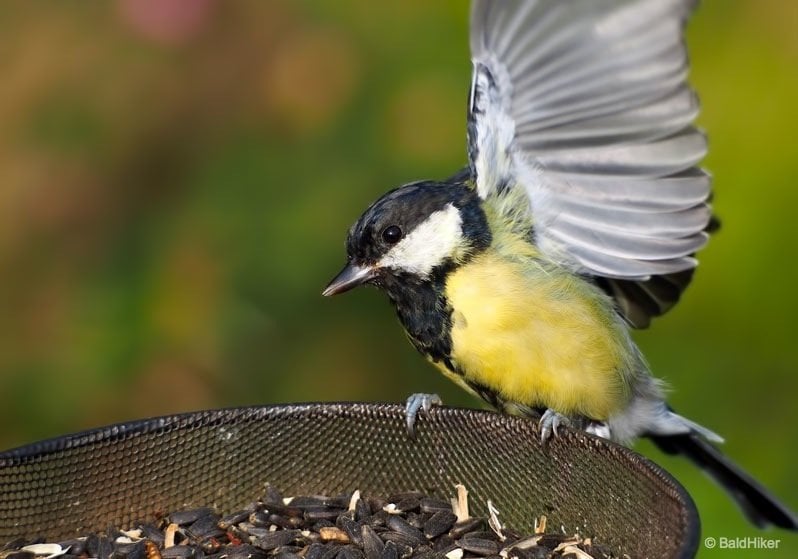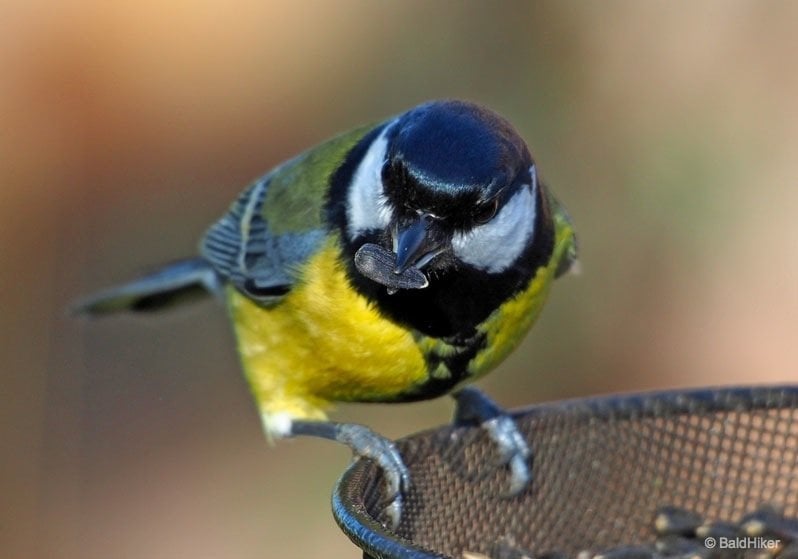Great Tits, known scientifically as Parus major, are small, charismatic songbirds that captivate bird lovers and researchers alike. With their vibrant colors and melodious calls, these birds have earned a special place in the hearts of nature enthusiasts.
Found across various habitats in the UK, including woodlands, gardens, and parks, Great Tits play a crucial role in the country’s ecosystem. Their importance lies in their diverse diet, nest building behavior, and role in pest control.
I find them an absolute joy to watch. They are a very frequent visitor to my bird feeders. Throughout the year I get to see them grow from youngsters to fully fledged adults. I always love to learn more about the world around me.

Let’s dive deeper into the significance of Great Tits in the UK ecosystem.
Habitat and Distribution of Great Tits in the UK
Preferred Habitats of Great Tits
Great Tits are commonly found in a variety of habitats including woodlands, forests, parks, gardens, and hedgerows. They generally prefer areas with a mix of trees and open spaces, which provide them with a diverse range of food sources and nesting opportunities.
Geographic Distribution and Range in the UK
Great Tits are widespread across the United Kingdom and can be found in various regions, including England, Scotland, Wales, and Northern Ireland. They have a broad geographic distribution and are present in both urban and rural areas throughout the country. From lowland areas to higher elevations, Great Tits can be found in diverse habitats across the UK.

Physical Description and Characteristics of Great Tits
Great Tits are medium-sized songbirds belonging to the Paridae family. Here are the key points about their physical description and characteristics:
Size: Great Tits measure around 12 to 14 centimeters (4.7 to 5.5 inches) in length, making them slightly larger than sparrows. In fact they are very much the largest tits of the 6 species that reside in the UK . And considerably so when you see one next to other kinds.
Shape: They have a robust and compact body with a rounded head and short, sturdy legs. Their wings are broad and rounded, enabling agile flight.

Coloration: Great Tits have distinctive plumage. The male has a striking black head, neck, and throat, which contrasts with a white cheek patch. Their back is greenish-yellow, and the underparts are yellow. The wings display a combination of black, white, and yellow markings. Females have similar coloration but with a duller appearance.
Notable physical features: The most notable physical feature of Great Tits is their prominent black stripe down the center of their yellow underparts, giving them a characteristic “bib” or “tie.” Additionally, their eyes are surrounded by a dark-colored stripe, enhancing their distinctive appearance.

Unique adaptations: Great Tits possess several unique adaptations. They have strong beaks, allowing them to crack seeds and feed on insects. They also have specially adapted feet with sharp claws, enabling them to cling to branches and search for food in tree bark. Another interesting adaptation is their ability to store food during the winter months, using specialized brain regions to remember the locations of hidden food caches.
Did you know that the Great Tit has a beak that changes subtly for the differing seasons? In summer their beaks are longer and thinner, making it easier to eat caterpillars. In the winter months their beaks get shorter and deeper to make it easier for seed consumption.
Juveniles: Young Great Tits are always a welcome sight on the bird feeders in spring. You can tell them not just by size but also in how their colours and stripes have not yet formally formed. They also may have some brown on their heads.

I always look forward to Spring, when the little , more fragile, ragged looking young ones come to start feeding.
Their Song or Call
Great Tits actually have differing songs that combine a total of up to 40 notes.
If you are listening to the birds singing at dawn and want to pick out a Great Tit then listen for the 2 note song repeated. Often written down as ‘tea-cher, tea-cher’.
Behavior and Life Cycle of Great Tits:
Great Tits exhibit various behaviors throughout their life cycle. Here are some key aspects:
Social and Breeding Behavior
Great Tits are social birds that typically form small flocks outside of the breeding season. During the breeding season, they establish territories and pairs form monogamous bonds. Males actively defend their territory and engage in territorial displays to attract females.
Nesting Habits and Parental Care

Great Tits build nests in tree cavities, crevices, or nest boxes. The female constructs the nest using materials such as moss, leaves, feathers, and hair. Once the nest is ready, the female lays an average of 7-10 eggs, which she incubates for about two weeks. Both parents take turns incubating the eggs and feeding the hatchlings.
After hatching, the parents continue to care for the young by providing them with food, mainly insects, caterpillars, and seeds. The parents feed the chicks until they are ready to fledge, which usually occurs around 17-21 days after hatching.
Migration and Seasonal Movements
These birds are partially migratory, meaning that some populations migrate while others remain resident. The decision to migrate or stay is influenced by factors such as food availability and environmental conditions.
In general, Great Tits from colder regions tend to migrate to warmer areas during the winter months. Migration distances can vary, with some individuals traveling only short distances, while others undertake longer migrations.
During the non-breeding season, Great Tits may join mixed-species flocks along with other bird species, forming foraging groups to increase their chances of finding food and protection.
I must admit I see plenty of Great Tits on my feeders all year round. Plentiful food source does seem to be a key.

Diet and Feeding Habits of Great Tits
The Great Tit has a diverse diet and feeding habits. It primarily feeds on insects, spiders, and other small invertebrates. Additionally, it consumes a variety of plant materials such as seeds, berries, and fruits.
Primary Food Sources
The primary food sources for Great Tits include caterpillars, beetles, moths, spiders, and ants. These insects are an essential part of their diet, especially during the breeding season when they require high protein levels to feed their young.

Foraging Techniques
They use various foraging techniques to obtain their food. They employ a method called “gleaning,” where they search for insects and spiders on leaves and branches. They also use a “hawking” technique, which involves catching insects while flying. Furthermore, they can extract seeds from cones and fruits by pecking or hammering them open.
Role in Pest Control and Seed Dispersal
Great Tits play a crucial role in pest control by preying on insects that can harm crops and trees. By feeding on caterpillars, beetles, and other pests, they help regulate their population naturally, reducing the need for chemical pesticides.
Moreover, Great Tits also contribute to seed dispersal. When they eat fruits and berries, they often drop the seeds during their flight or excrete them elsewhere, aiding in the dispersal and germination of plants.
Carnivores?
A classic innocent little songbird don’t you think? However, scientists have found a more sinister side to them and a study was done of the birds done in Hungary to help find out.
When food of the seed, worm or berry type is made unavailable for a Great Tit they have been found to then, as a last resort, to turn into carnivores. In Hungary these birds start hunting and eating bats there. Yes extremely adaptable.
Threats and Conservation of Great Tits
Habitat loss and fragmentation
Habitat loss and fragmentation pose significant threats to Great Tits. The destruction of forests and woodlands for urbanization, agriculture, and industrial development reduces suitable nesting and foraging sites for these birds. Fragmentation further isolates populations, limiting their ability to find mates and suitable habitats.
Predators and natural threats
Predation is a natural threat to Great Tits. Predators such as cats, squirrels, and birds of prey can reduce their population size. Additionally, severe weather conditions, including storms and harsh winters, can impact their survival rates.

Interactions with Humans
Cultural significance and folklore:
In various cultures, the Great Tit holds symbolic and folkloric significance. For example, in parts of Europe, like Estonia, it is believed that seeing a Great Tit near your home is a sign of good health, good luck and prosperity. In some folklore, the Great Tit is associated with protection against evil spirits or as a messenger from the spirit realm. These cultural beliefs have contributed to the positive perception of the Great Tit in many regions.
Best practices for attracting and supporting Great Tits in gardens:
Provide nesting boxes: Install nest boxes with an entrance hole of 28mm-32mm, as this size is suitable for Great Tits. Place them in a quiet, shaded area of the garden, away from predators.
Offer a diverse food supply: Great Tits have a varied diet, including insects, seeds, nuts, and suet. Provide a mix of feeders containing these food items to attract and support them.
Maintain a water source: Ensure there is a clean and fresh water source, such as a birdbath or shallow dish, for Great Tits to drink and bathe in. Keep the water source clean and regularly replenish it.
Create vegetation cover: Plant a variety of native trees, shrubs, and flowers to provide shelter, nesting sites, and natural food sources for Great Tits. Dense foliage and evergreen plants can offer year-round protection.
Avoid pesticide use: Minimize or eliminate the use of pesticides in your garden, as they can harm Great Tits and their food sources. Opt for natural pest control methods or integrated pest management techniques instead.
Reduce window collisions: Bird collisions with windows can be fatal. Use window decals or bird-safe window films to make windows more visible to Great Tits and reduce the chances of collisions.

Conclusion
The Great Tit is a bird we see so often we can take it for granted. I wanted to talk here more about them because they are a colourful mainstay in the garden and to show what wonderful creatures they are.
Next time I see a little young Great Tit I shall endeavour to will on and watch it and is siblings and friends grow and mature.
you may also like:









Lovely colourful birds and great photography! What camera do you use Paul?
Hi Nick. thanks.. I use the Olympus OM-D EM-5 .. I did a post in the ‘kit section’ here on the site to show how good it is for my travels
Excellent post, Paul. Terrific photos and very interesting commentary about the Great Tits.
Thanks kindly Scott. Got a few more posts like that lined up 😀
nice tits!
haha 😉